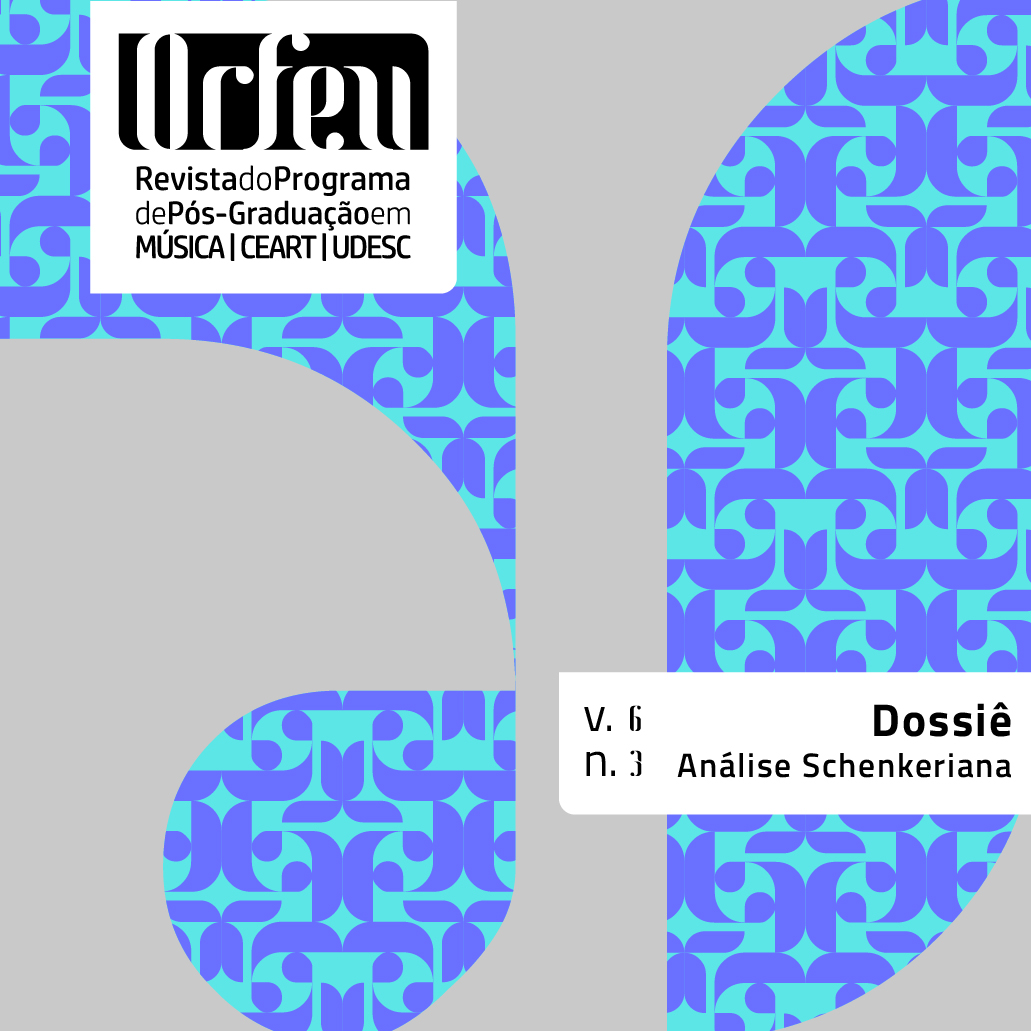Prolongation
DOI:
https://doi.org/10.5965/2525530406032021109Palavras-chave:
Prolongation, Auskomponierung, intervalo de tempo, profundidade, organicismoResumo
Este artigo evidencia e documenta as diferenças de significado entre o termo “prolongation” em inglês e Prolongation em alemão, assim como a própria maneira como Schenker concebia este termo. Enfatizando que, para Schenker, a palavra descreve a relação orgânica da Ursatz com o nível frontal, uma relação estabelecida na camada “profunda” da obra, enquanto em inglês este termo denota a extensão temporal de um evento harmônico ou melódico. A concepção inglesa de “prolongation” não é ilegítima, mas oculta uma parcela da dimensão que o termo tem para Schenker.Downloads
Referências
Berry, David Carson (2005). “Victor Vaughn Lytle and the Early Proselytism of Schenkerian Ideas in the U.S.” Journal of Schenkerian Studies 1, pp. 92–117.
Cook, Nicholas (2007). The Schenker Project. Culture, Race, and Music Theory in Fin-desiècle Vienna. Oxford, New York, Oxford University Press.
Dubiel, Joseph (1990). “When You are a Beethoven: Kinds of Rules in Schenker’s Counterpoint.” Journal of Music Theory, 34/ii, pp. 291-340.
Forte, Allen, and Steven E. Gilbert (1982). Introduction to Schenkerian Analysis. New York, Norton.
Goldenberg, Yosef (2008). Prolongation of Seventh Chords in Tonal Music. Lewinston, NY, Mellen Press. Vol. I, Text; vol. 2, Examples.
Grimm, Jakob and Wilhelm (1889). Das Deutsche Wörterbuch, vol. VII, N, O, P, Q. Leipzig, S. Hirzel. Online, http://dwb.uni-trier.de/de/ (last checked 14/03/2021).
Katz, Adele T. (1935). “Heinrich Schenker’s Method of Analysis.” The Musical Quarterly 21/3, pp. 311-329.
Katz, Adele T. (1945). Challenge to Musical Tradition. A New Concept of Tonality. Knopf, New York.
Koslovsky, John Ch. (2009). From Sinn und Wesen to Structural Hearing: The Development of Felix Salzer’s Ideas in Interwar Vienna and Their Transmission in Postwar United States. PhD Thesis, University of Rochester.
Krünitz, D. Johann Georg (1811). Oekonomische Encyklopädie oder allgemeines System der Staats- Stadt- Haus- u. Landwirthschaft, vol. 117, Berlin, J. Pauli, s.v. Prolongation. Online: http://www.kruenitz1.uni-trier.de/xxx/p/kp07807.htm (last checked 14/03/2021).
Lerdahl, Fred, and Ray Jackendoff (1983). A Generative Theory of Tonal Music. Cambridge, Mass., The MIT Press.
Lytle, Victor Vaughn (1931). “Music Composition of the Present: An Analysis of the Trend of Composition Based on the Proved Achievement of the Greatest Masters of Past Centuries.” The American Organist 14/11, pp. 661-666, quoted in Berry (2005).
Meeùs, Nicolas (2015). “Formenlehre in der freie Satz: A Transformational Theory.” Schenker’s Formenlehre, Rivista di Analisi e Teoria Musicale XXI/2, pp. 99-113.
Meißner, Johann Karl (1836-1837). Codex der europäischen Wechsel-Rechte oder Sammlung der heutzutage in Europa geltenden Wechsel-Gesetze. Nürnberg, J. L. Schrag. Vol. 1, 1836, Die deutschen Wechselgesetze. Vol. 2, 1837, Die Wechselgesetze außerhalb der deutschen Bundesstaaten.
Meyer, Hermann Julius (1850). Meyer’s Großes Konversationslexicon, Zweite Abteilung, vol. 4. Hildburghausen, Verlag des Bibliographischen Instituts.
Morgan, Robert P. (1976). “Dissonant Prolongation: Theoretical and Compositional Precedents.” Journal of Music Theory 20/1, pp. 49-91.
Salzer, Felix (1952). Structural Hearing. Tonal Coherence in Music. 2 vols., New York, Boni.
Schenker, Heinrich (1906). Harmonielehre. Stuttgart, Berlin, Cotta. Harmony (1954), O.
Jonas ed., E. Mann Borghese transl. Chicago, The University of Chicago Press.
––––– (1910). Kontrapunkt 1. Wien, Universal. Counterpoint I (1987), J. Rothgeb and J. Thym transl. New York, Schirmer.
––––– (1922). Kontrapunkt 2. Wien, Universal. Counterpoint II (1987), J. Rothgeb and J. Thym transl. New York, Schirmer.
––––– (1923a). “J. S. Bach: Zwölf kleine Präludien, Nr. 3 [BWV 999].” Der Tonwille 5, pp. -4. Der Tonwille I (2004), J. Dubiel transl., pp. 175-176.
––––– (1923b). “J. S. Bach: Zwölf kleine Präludien, Nr. 5 [BWV 926].” Der Tonwille 5, pp. -9. Der Tonwille I (2004), J. Dubiel transl., pp. 180-181.
––––– (1923c). “Beethoven: V. Sinfonie (1. Fortsetzung).” Der Tonwille 5, pp. 10-42. Der Tonwille I (2004), W. Drabkin transl., pp. 182-209.
––––– 1923d). “Vermischtes.” Der Tonwille 5, pp. 43-57. Der Tonwille I (2004), J. Lubben transl., pp. 210-225.
––––– (1924). “Erläuterungen.” Der Tonwille 8/9, pp. 49-51. This text was published also in Der Tonwille 10 (1924), pp. 40-42 and in Das Meisterwerk in der Musik 1 (1925), pp. 203-, and 2 (1926), pp. 195-197.
––––– (1925). “Domenico Scarlatti. Sonate für Klavier D-Moll.” Das Meisterwerk in der Musik 1, pp. 125-137. The Masterwork in Music I (1994), I. Bent transl., pp. 67-74.
––––– (1930). “Rameau oder Beethoven? Erstarrung oder geistiges Leben in der Musik?” Das Meisterwerk in der Musik 3, pp. 9-24. The Masterwork in Music III (1994), I. Bent transl., pp. 1-9.
––––– (1935). Der freie Satz. Vienna, Universal. 2d edition, O. Jonas ed., 1956. Free Composition, E. Oster transl. of the 2d edition, New York and London, Longman, 1979.
L’Écriture libre, N. Meeùs transl. of the 2d edition, Liège, Mardaga, 1993.
Snarrenberg, Robert (1996). “The Art of Translating Schenker: A Commentary on The Masterwork in Music, Vol. 1”. Music Analysis 15/2-3, pp. 301-342.
Väisälä, Olli (2004). Prolongation in Early Post-Tonal Music. Studia Musica 23. Helsinki, Sibelius Academy.
Weigand, Fr. L. K. (1910). Deutsches Wörterbuch, 5th ed., H. Hirt ed., vol. II, Gießen, A. Töpelmann.
Downloads
Publicado
Como Citar
Edição
Seção
Licença
Copyright (c) 2021 Nicolas Meeùs

Este trabalho está licenciado sob uma licença Creative Commons Attribution 4.0 International License.






